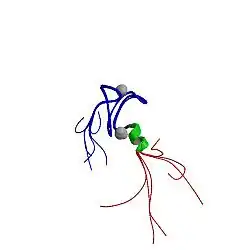Autoimmun-Regulator
Das Protein Autoimmun-Regulator (AIRE) ist ein Transkriptionsfaktor, der an der Vermeidung von Autoimmunität bei der Bildung von T-Zellen beteiligt ist.[1]
| AIRE | ||
|---|---|---|

| ||
| nach PDB 1xwh | ||
| Andere Namen |
APECED-Protein | |
| Eigenschaften des menschlichen Proteins | ||
| Masse/Länge Primärstruktur | 57,7 Kilodalton / 545 Aminosäuren (Isoform 1 / AIRE-1)
35,7 Kilodalton / 338 Aminosäuren (Isoform 2 / AIRE-2) | |
| Isoformen | 4 | |
| Bezeichner | ||
| Gen-Namen | AIRE APECED | |
| Externe IDs | ||
| Orthologe | ||
| Mensch | Hausmaus | |
| Entrez | 326 | 11634 |
| Ensembl | ENSG00000160224 | ENSMUSG00000000731 |
| UniProt | O43918 | Q9Z0E3 |
| Refseq (mRNA) | NM_000383 | NM_001271549 |
| Refseq (Protein) | NP_000374 | NP_001258478 |
| Genlocus | Chr 21: 44.29 – 44.3 Mb | Chr 10: 78.03 – 78.04 Mb |
| PubMed-Suche | 326 | 11634 |
Eigenschaften
AIRE wird am Übergang der Rinde zum Mark des Thymus in Epithelzellen (mTEC, von englisch medullary Thymic Epithelial Cells) gebildet. Die mTEC sind CD45-negativ, CD40-, CD80- und PD-L1-positiv,[2] EpCAM-positiv, Ly51-positiv Cytokeratin-5-positiv und Cytokeratin-14-positiv.[3] AIRE bindet an das CREB-Binding-Protein. Weiterhin induziert AIRE als Transkriptionsfaktor die Genexpression mehrerer tausend verschiedener gewebsspezifischer Autoantigene,[3][4] die nach einem Abbau im Proteasom über die Translokase TAP in das endoplasmatische Retikulum transportiert werden, wo sie an MHCI-Proteine binden. Aus dem endoplasmatischen Retikulum erfolgt die Exozytose der Autoantigene an die Zelloberfläche. Auf der Zelloberfläche werden die Autoantigene an MHCI-Proteine gebunden präsentiert. Binden entstehende T-Zellen daran, wird in diesen autoreaktiven T-Zellen die Apoptose ausgelöst (Negativselektion). Dadurch ist AIRE an der Ausbildung einer zentralen Immuntoleranz gegen Autoantigene beteiligt.[5] Bei fehlerhafter Negativselektion können T-Zell-basierte Autoimmunerkrankungen entstehen. Weiterhin induziert AIRE die Ausbildung von regulatorischen T-Zellen, die zur peripheren Immuntoleranz beitragen.[6]
Ein Gendefekt im Gen von AIRE ist an der Entstehung der Autoimmunerkrankung APECED beteiligt.[7]
Einzelnachweise
- R. Perniola, G. Musco: The biophysical and biochemical properties of the autoimmune regulator (AIRE) protein. In: Biochimica et Biophysica Acta. Band 1842, Nummer 2, Februar 2014, ISSN 0006-3002, S. 326–337, doi:10.1016/j.bbadis.2013.11.020, PMID 24275490.
- F. X. Hubert, S. A. Kinkel, K. E. Webster, P. Cannon, P. E. Crewther, A. I. Proeitto, L. Wu, W. R. Heath, H. S. Scott: A specific anti-Aire antibody reveals aire expression is restricted to medullary thymic epithelial cells and not expressed in periphery. In: Journal of Immunology (Baltimore, Md. : 1950). Band 180, Nummer 6, März 2008, ISSN 0022-1767, S. 3824–3832, PMID 18322189.
- M. S. Anderson, M. A. Su: Aire and T cell development. In: Current opinion in immunology. Band 23, Nummer 2, April 2011, ISSN 1879-0372, S. 198–206, doi:10.1016/j.coi.2010.11.007, PMID 21163636, PMC 3073725 (freier Volltext).
- K. Zumer, K. Saksela, B. M. Peterlin: The mechanism of tissue-restricted antigen gene expression by AIRE. In: Journal of Immunology (Baltimore, Md. : 1950). Band 190, Nummer 6, März 2013, ISSN 1550-6606, S. 2479–2482, doi:10.4049/jimmunol.1203210, PMID 23456700.
- M. Laan, P. Peterson: The many faces of aire in central tolerance. In: Frontiers in immunology. Band 4, 2013, ISSN 1664-3224, S. 326, doi:10.3389/fimmu.2013.00326, PMID 24130560, PMC 3795325 (freier Volltext).
- S. Yang, N. Fujikado, D. Kolodin, C. Benoist, D. Mathis: Regulatory T cells generated early in life play a distinct role in maintaining self-tolerance. In: Science. 348, 2015, S. 589, doi:10.1126/science.aaa7017.
- Finnish-German APECED Consortium: An autoimmune disease, APECED, caused by mutations in a novel gene featuring two PHD-type zinc-finger domains. In: Nature genetics. Band 17, Nummer 4, Dezember 1997, ISSN 1061-4036, S. 399–403, doi:10.1038/ng1297-399, PMID 9398840.